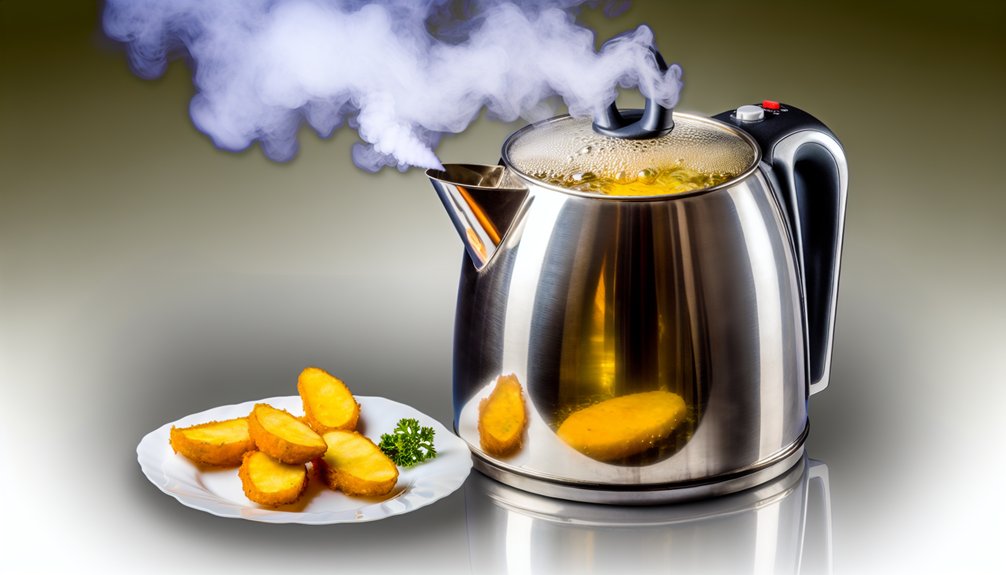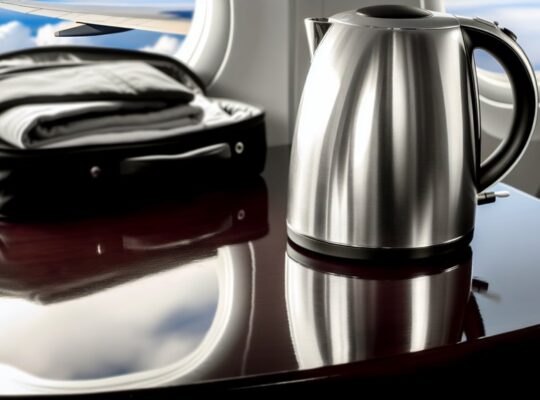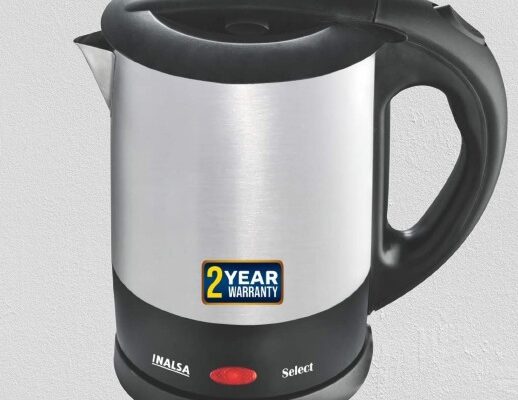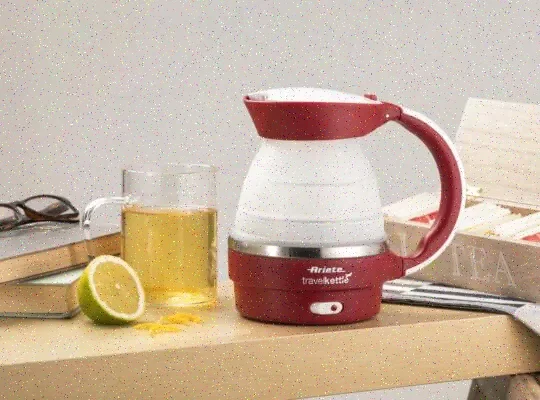Yes, you can fry in an electric kettle, but you need to be careful. Maintain a frying temperature of 350°F to 375°F for the best results. Use oils with high smoke points, like canola or peanut oil, to avoid burning. Monitor the temperature closely to prevent overheating, as this can pose safety risks. Always clean the kettle thoroughly after use. If you want tips for successful frying and alternative methods, keep going to find out more.
Key Takeaways
- Electric kettles are primarily designed for boiling water, not frying, making them unsuitable for deep frying foods.
- Frying requires maintaining specific temperatures (350°F to 375°F) which electric kettles may not be able to regulate effectively.
- Using oil in an electric kettle can pose safety hazards, including overheating and potential fire risks with hot oil.
- High smoke point oils are necessary for frying, but kettles lack temperature control features to manage oil heat properly.
- Cleaning an electric kettle after frying is challenging, and leftover oil can lead to cooking hazards and malfunction over time.
Understanding Electric Kettles and Their Functionality
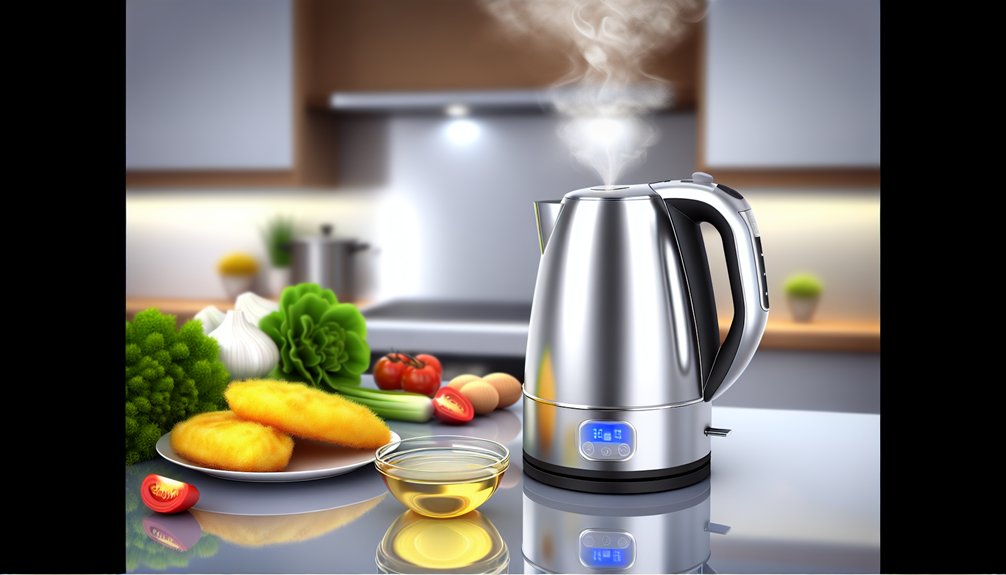
While you might think of an electric kettle primarily for boiling water, understanding its functionality reveals a versatile kitchen tool. The electric kettle design often features a sleek body, usually made from stainless steel or glass, that houses powerful kettle heating elements. These elements are strategically placed to guarantee rapid heating, allowing you to boil water quickly and efficiently. Beyond just boiling, you can use an electric kettle for preparing various hot beverages, like tea or coffee, and even for instant soups or oatmeal. Some models include temperature settings, enabling you to heat water to precise degrees, ideal for different types of tea. Therefore, this appliance can elevate your cooking experience far beyond simple water boiling, thanks to its multi-purpose functionality.
The Science of Frying: Temperature and Oil
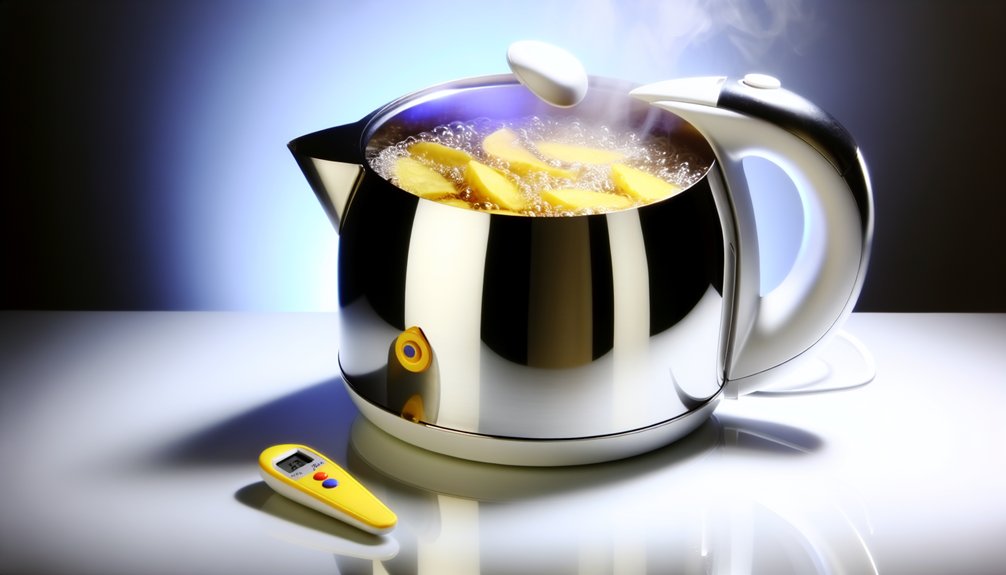
To achieve perfect frying, you need to pay close attention to temperature and oil type. The ideal frying temperature typically hovers around 350°F to 375°F, allowing food to cook quickly while forming a crispy outer layer. Additionally, the choice of oil greatly impacts flavor and smoke point, so selecting the right one is essential for successful frying.
Frying Temperature Essentials
Have you ever wondered why temperature plays such an essential role in frying? The right frying temperature can dramatically affect your dish’s texture and flavor. Here are three key points to keep in mind:
- Optimal Temperature: Most frying techniques require oils heated between 350°F to 375°F. This range guarantees food cooks evenly and forms a crispy exterior.
- Oil Absorption: If the oil’s too cool, food absorbs more oil, resulting in greasiness. Conversely, excessive heat can burn the exterior before the inside cooks properly.
- Safety: Maintaining the right temperature helps prevent dangerous flare-ups and guarantees safer cooking.
Oil Type Matters
Choosing the right oil is essential for achieving perfect frying results, as different oils have varying smoke points and flavor profiles. When frying, you’ll want oils with high smoke points, like canola or peanut oil, to prevent burning and off-flavors. Oil viscosity also plays an important role; thinner oils allow for a crisper texture, while thicker oils can add richness but may absorb more food particles. Avoid using olive oil for deep frying, as its lower smoke point can lead to undesirable results. Experiment with frying oils to find the right balance between taste and texture. Remember, the oil you choose can greatly impact your fried dishes, so select wisely to achieve that perfect crunch.
Potential Foods to Fry in an Electric Kettle
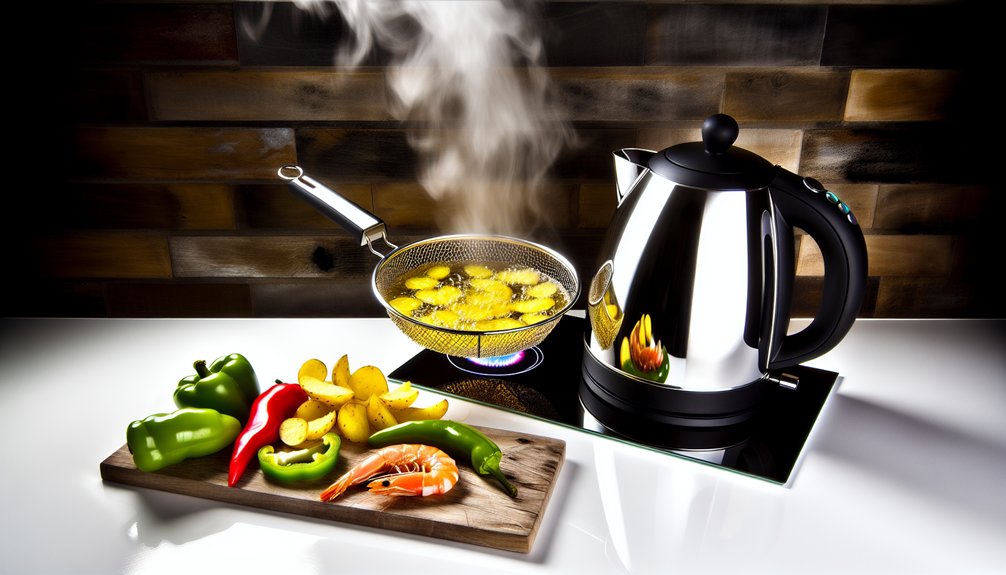
Frying in an electric kettle opens up a world of culinary possibilities, allowing you to experiment with various foods that can achieve that crispy, golden perfection. You can create delicious fried snacks using simple kettle recipes that elevate your meals. Here are three potential foods you might consider frying:
- French Fries: Cut potatoes into sticks, season them, and let the kettle work its magic for crispy fries.
- Chicken Wings: Coat wings in your favorite spices and fry them until they’re golden brown and juicy.
- Vegetable Tempura: Dip assorted vegetables in batter and fry them for a crunchy, delightful snack.
With these options, you can enjoy homemade fried treats right from your electric kettle!
Safety Considerations When Frying in an Electric Kettle
When frying in an electric kettle, you need to be mindful of temperature control challenges, as maintaining the right heat can be tricky. Inadequate monitoring can lead to overheating and potential fire hazards, putting your safety at risk. Always prioritize caution and consider these factors before attempting to fry anything in your kettle.
Temperature Control Challenges
Although electric kettles are primarily designed for boiling water, using them for frying presents unique temperature control challenges that can compromise safety. You may encounter significant temperature fluctuations, which can affect cooking consistency and lead to undercooked or overcooked food. Here are three critical factors to evaluate:
- Limited Temperature Range: Kettles typically heat to a rapid boil, making it hard to maintain lower frying temperatures.
- Inconsistent Heat Distribution: The design may cause uneven heating, leading to hot spots that can burn food.
- Automatic Shut-off Features: Many kettles shut off when reaching a certain temperature, interrupting your cooking process.
Additionally, the thermostat controls the heating element, which may not be suitable for frying due to its rapid temperature changes. Being aware of these challenges helps you make informed decisions about frying in an electric kettle.
Potential Fire Hazards
Using an electric kettle for cooking can introduce significant fire hazards that you should be aware of. When frying, the combination of hot oil and electrical components can lead to dangerous situations. To guarantee fire safety, always monitor the kettle and never leave it unattended. Proper kettle maintenance also plays an essential role; regularly check for any signs of wear or damage.
Here’s a quick overview of potential hazards:
| Hazard | Safety Tip |
|---|---|
| Overheating | Use the kettle for its intended purpose only. |
| Oil Spills | Keep a lid nearby to cover spills. |
| Electrical Malfunctions | Inspect cords and plugs regularly. |
| Flammable Materials | Keep combustibles away from the kettle. |
| Unattended Cooking | Always stay present while cooking. |
Stay safe and be cautious!
Tips for Successfully Frying in an Electric Kettle
How can you make the most of frying in an electric kettle? With the right approach, you can create delicious fried dishes while maintaining your kettle. Here are some tips to guarantee success:
- Choose the Right Oil: Use oils with high smoke points, like canola or peanut oil, to prevent burning and guarantee effective frying techniques.
- Monitor Temperature: Keep an eye on the kettle’s temperature. Overheating can damage the kettle and ruin your food, so adjust the heat as needed.
- Clean Regularly: After frying, guarantee proper kettle maintenance by cleaning it thoroughly. Residual oil can lead to smoke or fire hazards during future use.
Alternatives to Frying in an Electric Kettle
If you’re looking for alternatives to frying in an electric kettle, several methods can help you achieve that crispy texture without the potential hazards. Here are some frying alternatives you can try:
| Cooking Method | Description | Best For |
|---|---|---|
| Air Frying | Uses hot air circulation to fry food | Healthier fries |
| Deep Frying | Submerging food in hot oil | Classic fried dishes |
| Pan Frying | Cooking in a small amount of oil | Quick, easy meals |
| Oven Baking | Uses dry heat for a crispy finish | Roasting vegetables |
| Sautéing | Quickly cooking in a little oil | Flavorful dishes |
These cooking methods not only provide delicious results but also offer safer and healthier options for your meals.
Frequently Asked Questions
Can I Use Any Electric Kettle for Frying?
You can’t use just any electric kettle for frying. Consider its heating capacity and follow safety precautions. Using an unsuitable kettle might lead to overheating or damage, so choose wisely to guarantee safe cooking.
What Types of Oil Are Best for Frying?
For frying, use oils with high smoke points, like canola or peanut oil. They withstand higher oil temperatures, ensuring better frying techniques. Always monitor the temperature to achieve crispy, evenly cooked results without burning.
How Long Does It Take to Fry Food?
Frying time varies based on food types; for instance, thin items like fries take about 4-5 minutes, while thicker foods, like chicken, may need 10-15 minutes. Always check for golden brown doneness to guarantee perfect results.
Can I Fry Frozen Foods in an Electric Kettle?
You can fry frozen foods in an electric kettle, but it’s crucial to adjust cooking times and temperatures. Using proper cooking methods guarantees even frying and prevents sogginess, delivering delicious results without compromising safety.
Will Frying in an Electric Kettle Damage It?
Frying in an electric kettle can pose frying risks, potentially damaging the kettle. The high temperatures and oil buildup might compromise its safety, leading to malfunctions or hazards. It’s safer to use traditional frying methods instead.
Conclusion
To sum up, while frying in an electric kettle is possible, it requires careful consideration of safety and technique. Monitor the temperature closely to avoid overheating, and choose suitable foods that won’t create excessive splatter. Always prioritize safety by keeping an eye on the kettle and having a fire extinguisher nearby. If you’re unsure or want to play it safe, consider using traditional frying methods or appliances designed for frying. Enjoy your cooking adventures!
